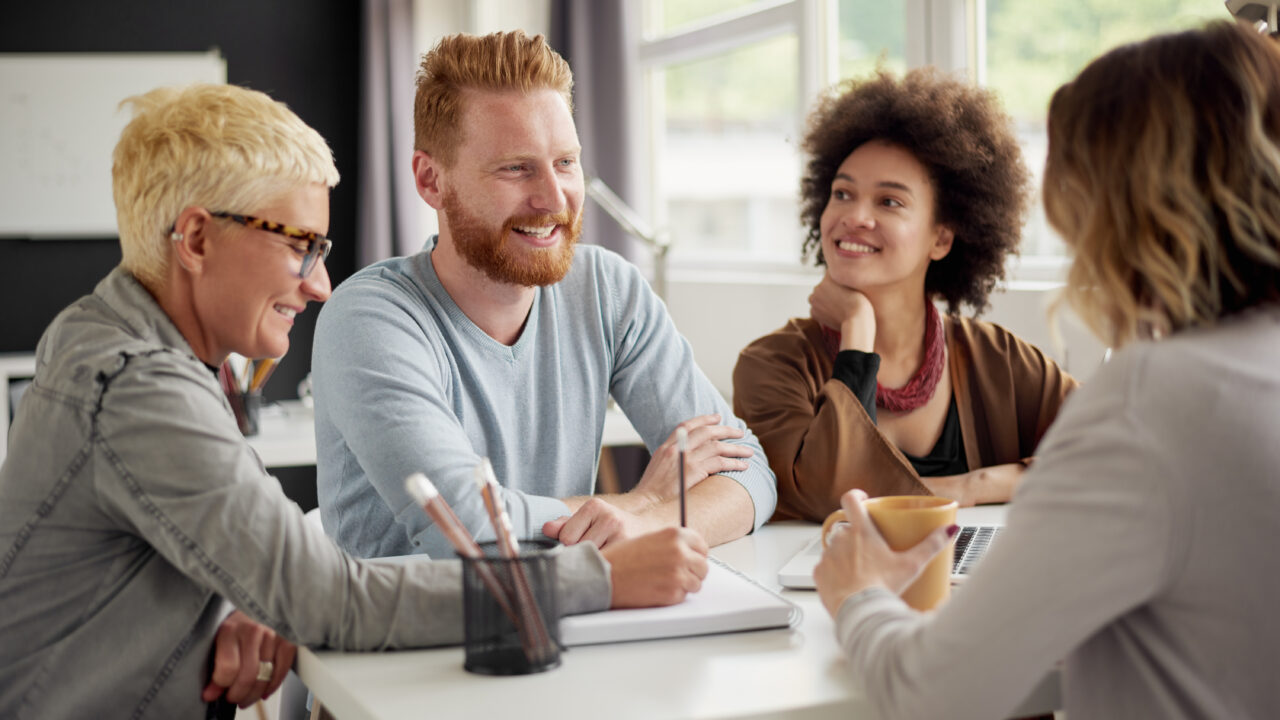At first, you may find yourself nervous about planning a conference, but don’t worry; we’ve got you covered. As you plan your event, simplify the process by following our Conference Planning Guide for 2024. This guide is designed to help you plan your event, from start to finish, every step of the way. With a little direction, an artistic vision, and time, you can create an amazing conference.
Pre-Conference Planning
Ideally, you should begin planning your conference about 12 months in advance. Ask yourself what you would like to accomplish with this event. Then, take a few minutes to write down which personnel have talents that can help you plan your conference.
Identify and find your target audience
Increasing the number of people who attend your event is a top priority, which means that you need to know who you are targeting and how you can find them. To accomplish this, you need to create a customer persona, find these customers, and then use targeting strategies to promote engagement.
Characteristics that can help you create a customer persona include:
- Age
- Occupation
- Gender
- Location
- Ethnic background
- Education level
- Family or marital status
- Income level
Find your potential attendees:
- Consider current clients.
- Get a list of people who have attended previous conferences.
- Look for companies planning similar events and see which targeting strategies they are using.
Consider these potential targeting strategies:
- What types of images, designs, and language are they using in their promotional materials?
- Which websites and social media sites are they using to promote their event?
Assemble your team
Singlehandedly planning a conference is nearly impossible, so you will be putting together groups of people who can help make your event unforgettable.
You will most likely need a team that consists of the following groups:
- Communications and marketing. Even internal events need to be promoted. These team members will build hype by creating promotional materials and sending messages out to potential attendees.
- Physical planning. These team members will handle tasks like booking the venue, and assisting attendees with travel and hotel accommodations.
- Facilitators. Your facilitators make sure that everything is up to par, they help attendees get where they need to be and are prepared to handle unforeseen tasks that arise.
- Administrators. Essentially, the administrators’ main purpose is to answer questions. Therefore, these team members must be aware of everything going on.
Set your objectives and establish your goals
To have a clear vision, you need to determine your objectives and establish your goals as soon as you decide to plan your event.
- What do you want to accomplish?
- Are you launching a new product, networking, or promoting employee engagement?
- Would you like to build relationships and generate leads?
- Is your conference meant to be educational?
Your event goals may include touching base with others in your industry to share ideas, or facilitating a particular number of B2B meetings.
Come up with a theme and format
Whether you are having an onsite conference or a hybrid event, a good theme can make it or break it. Therefore, your theme must be snappy, inspirational, and unforgettable. Also, remember to keep it short, making it no more than a single sentence. You can use a tagline to add more information. The tagline is typically a little longer than the theme itself. For instance, your theme may be “Embracing Technology” with a tagline that reads “Making Life Easier, One Circuit at a Time.”
Create a master plan
Naturally, once you have your theme, you should envision the experience that you want to create for your attendees. Your goal should be to make sure conference participants are comfortable and have positive, memorable experiences.
Event touchpoints
Your event touchpoints include everything from the invitation to be part of your event to accommodations and transportation, the first point of contact they have with you or a team member, the food you provide, and the technology you use.
Touchpoint tips:
- Create a good first impression with a unique logo and theme. Each touchpoint and every step of an attendee’s journey needs to reinforce your theme as well as the overall goal of your conference. Avoid making this interaction overt; instead, just make sure it is present in the background of all the aspects of your event. You can explore what the attendees of your event experience by navigating their journey. What impresses you the most? Does anything seem superfluous?
- If you have a website for your event, make sure it is easy to use and the registration process is simple.
- Since communication plays a key role in setting the tone of your conference, make sure every type is addressed efficiently, effectively, and professionally.
- Directly upon entering your venue, attendees need to know where to go. Therefore, have several of your most personable staff members at a desk near the entrance. That way, they can quickly provide information about the event and direct attendees to the appropriate area.
- Offer attendees several accommodation options. Choose options that are suitable for a range of budgets. In addition, ensure the accommodations can meet all the attendees’ needs.
- If you are supplying food, make sure you offer a wide variety. For example, you must be able to accommodate attendees who follow a vegan or vegetarian diet.
Evaluating your touchpoints
As you begin to design and delegate tasks for your event, you can evaluate your potential touchpoints by asking yourself several questions.
Questions to ask yourself:
- Is each touchpoint moving my attendees in the direction of the overall goal of the event?
- Do any of my touchpoints lack impact? Are some of them unnecessary? These two questions are especially important as you consider your budget.
- Have I examined my event through the eyes of a random attendee?
- Does the journey’s end reflect the overall goal of my conference?
Develop a budget
When the time comes to create your budget, you need to be specific about costs and remember to keep an eye out for any hidden fees.
You may think addressing each touchpoint separately is easier than planning all your costs at the same time. However, this is not the case. By creating each aspect of your budget concurrently, you can avoid unexpected last-minute variables. One potential variable could be that you have budgeted a particular amount of money for the venue but find out that the date you want is no longer available. And the only other date available is more expensive, which means you’ll have to modify your budget. You may be able to avoid additional costs by considering several venues for your event. This ensures that if plans change, your conference can still move forward.
When determining your event date and choosing a venue, be sure to select days that do not coincide with holidays, sporting events, or local festivals.
Keep an eye out for these hidden event-planning fees
Hidden event costs are frequently added during the event, which means that you will not see the true cost of your event until it is over. Therefore, make sure you and your vendors discuss and agree on costs ahead of time. If there are variables to consider, let the vendors know to check with you before they add anything extra to your bill.
Hidden event planning fees to watch out for:
- Audiovisual supplies (e.g., power strips, flip charts)
- Conference calls
- Credit card processing fees
- Onsite staffing (including vendors)
- Service charges
- Taxes
- Gratuities
- Web-building costs
- Wi-Fi access
- Unexpected event attendees
Select the right conference technology
When it comes to technology, there are plenty of options available. While you may consider some of these options absolutely necessary (e.g., social media walls and an event app), you may also want to give your attendees a wow factor. You can accomplish this with facial recognition or kiosk check-in, and AI chatbots to answer questions.
How to make the most of conference technology:
- Complement written information and guidance with webinars and video tutorials.
- Use visual aids to incorporate flowcharts, infographics, and timelines. These aids can help attendees envision more intricate concepts.
- Create an interactive community or forum that participants can use to ask questions and exchange experiences.
- Remember that any technology you select for your conference must cater to a variety of learning styles.
- Create a conference app. Your conference app can deliver the same benefits as traditional paper, and more.
Although a heavy focus on technology is not a necessity for every conference, providing a streamlined technological experience frequently results in attendees viewing your event as a positive experience.
Conference Planning Timeline
9–12 Months Before the Conference
Confirm date(s)
Verify times and dates with your speakers, vendors, caterers, and venue. For example, you may want to verify the time you can arrive at the venue and find out when the vendors will arrive. Take notes so you can remember what is happening and when.
6–9 Months Before the Conference
Find sponsors and exhibitors
If there is no budget for your event, you will have to find ways to entice people and businesses to sponsor your conference. As you meet with potential sponsors, be sure to explore ways that participating in your event as a sponsor is beneficial for them.
Your keynote speaker
Whereas an inexperienced keynote speaker can make an event memorable for all the wrong reasons, an experienced speaker typically highlights an event.
As you begin the task of looking for a speaker, ask yourself the questions below:
- What is the overall goal of the event? Does this individual coincide with that?
- Who is your target audience? Can this speaker resonate with them?
- Can you afford to hire this speaker?
- Is the speaker available on the day of your conference?
- What do you expect from this speaker? Can they deliver?
Once you have an idea of what skills your speaker must have, it’s time to start looking for a person who can fill these shoes. To begin your search, consider asking for referrals from people in the same industry who may have hosted a conference focusing on a similar theme. You can also try looking at the pages of clubs or organizations that relate to the theme of your conference.
Develop branding
To develop your branding, think about how people will engage with your content. Consider the places that will be used to take photos and where attendees will frequently be looking. Proper placement of promotional materials provides free publicity for you and your sponsors.
3–6 Months Before the Conference
Recruit volunteers
If you need volunteers, consider starting your search approximately six months before your conference, but no later than three months.
Find suppliers
If you are providing food and beverages and the venue you choose does not offer these services, you need to find a reputable caterer. Either way, ask if you can schedule a tasting. This may or may not be an option, and there may be a charge for this service. Whatever the case, a tasting can ensure that the food you offer attendees is presented beautifully and tastes delicious.
Start promoting
The time has come to explore a topic that can be really easy or extremely tricky—that topic is promotion.
An internal event:
If your conference is internal, promoting your event should be rather simple. You can start by creating a communications plan. In the months leading up to the conference, work with your team and find ways to pique the interest of potential attendees.
A month before your event, send out a save-the-date message. Make sure this message provides all the information participants need, including links to your event’s website and registration form. A few days before your conference, you need to send out a reminder. If you still have openings, go ahead and provide all the information and registration link again. That way, people interested in attending who have yet to register can go ahead and do so.
An external event:
If your event participants are going to include external visitors, your task is a bit more complicated. Unless your conference is free, you need to settle on a ticket price. You will most likely use a variety of avenues to reach out to your target market. As you do so, just remember to remain consistent.
Although most of your promotional content will be digital, if your business has a lot of traffic, offline materials may also be useful. If this is the case, consider creating a poster or a well-designed pamphlet.
Social media advertising can benefit internal and external events.
One of the least expensive ways to promote your event is through social media. Consider advertising on Facebook, Twitter (X), LinkedIn, and Instagram. If possible, find a small group of influencers who have a wide reach in the market you’re targeting to see if they are willing to share your event on their social channels. This advertising approach is frequently more effective than cold social media messages and emails.
1 Month Before the Conference
Finalize tasks with your team, volunteers, speakers, and venue
Discuss the remaining tasks that have yet to be completed. In addition, if you’re allotting a specific amount of time for your speaker(s), designate someone to create timecards. Holding up a timecard lets speakers know how much time they have left. This is helpful because it gives them the information they need to determine if they should move things along quicker or begin wrapping up. Consider creating timecards for the 20-, 10-, 5-, and 2-minute marks.
1 Week Before the Conference
A few days before your event, schedule a meeting. Taking some time to ensure that every team member understands the plan for each day of your event is essential. Once again, verify your venue.
Make sure your conference room is easy to manage and accessible to all. For example, some attendees may use a wheelchair; in this case, the ability to move furniture around helps these participants enjoy the event without worrying about getting where they need to go.
1 Day Before the Conference
Have another meeting the morning before your event. During this meeting, you can handle last-minute details.
During the Conference
Make it easy to check your attendees in as they arrive with apps that can streamline this process.
You need to set the scene for your event with an opening address. Welcome the participants, mention key points, and introduce your agenda.
Create an easy-to-follow paper or digital agenda that participants can refer to. If you’re planning a conference that will last several days, this agenda is vital. It should detail start and end times, general breaks, meal times, and transportation information.
You should plan your time in one- or two-hour blocks. This ensures there is an adequate amount of time for your speakers to make the important points, while eliminating the additional time that could result in wandering minds.
Since it is difficult to remain engaged when you are hungry or directly after eating a meal, avoid scheduling topics that are especially important before and after breakfast, lunch, or dinner.
Explore the benefits of starting early or ending late. Sometimes, it is better to start a conference in the latter part of the morning because participants will be more alert than if you started at 8 a.m.
After the Conference
Follow-up communication loses its usefulness rather quickly. Therefore, the key to benefiting the most from the connections you made at your conference is to strike while the iron is hot. In general, wait no longer than a week to follow up; after that, the likelihood of your participants responding decreases.
A feedback survey helps you determine which aspects of your event participants found the most interesting or useful. Furthermore, you can add an opt-in checkbox so people who are interested in future events will receive the information they need to register.
Extra Tips for Successful Conference Planning
Develop plans for addressing unforeseen circumstances, including health crises, natural disasters, and technical issues. Having contingency plans ensures that you maintain control over your event, even if an emergency arises.
Consider any challenges associated with your industry niche or the region where you are having your event. By tailoring your approach to suit specific circumstances, you increase the likelihood of a successful event.
Remember that your conference environment must accommodate everyone who attends, including those with disabilities.
Final Thoughts
Let our Conference Planning Guide for 2024 help direct you as you move forward in the event planning process. With this guide, a motivated team, a little creativity, and organizational skills, you should be able to set up a positive, memorable, and enjoyable event.
Furthermore, knowing what your members want can help guide you as you broaden your membership base. To learn more about what we can do for you, book your MemberClicks demo today.
















